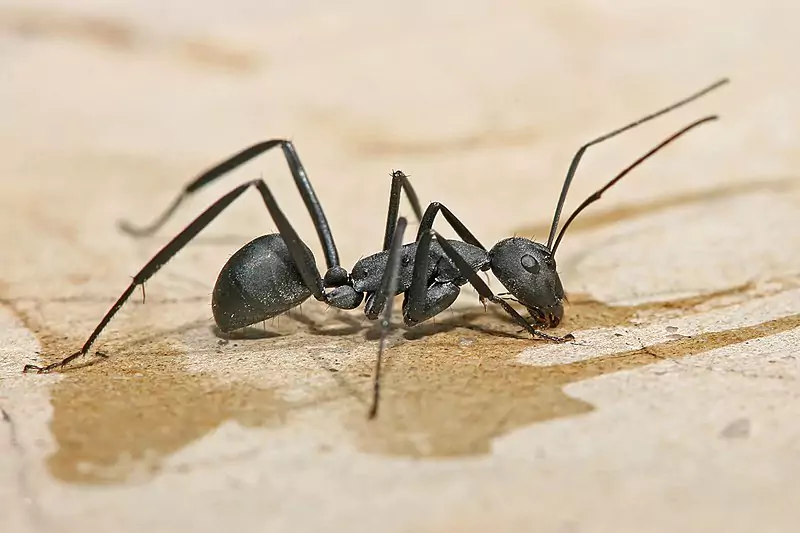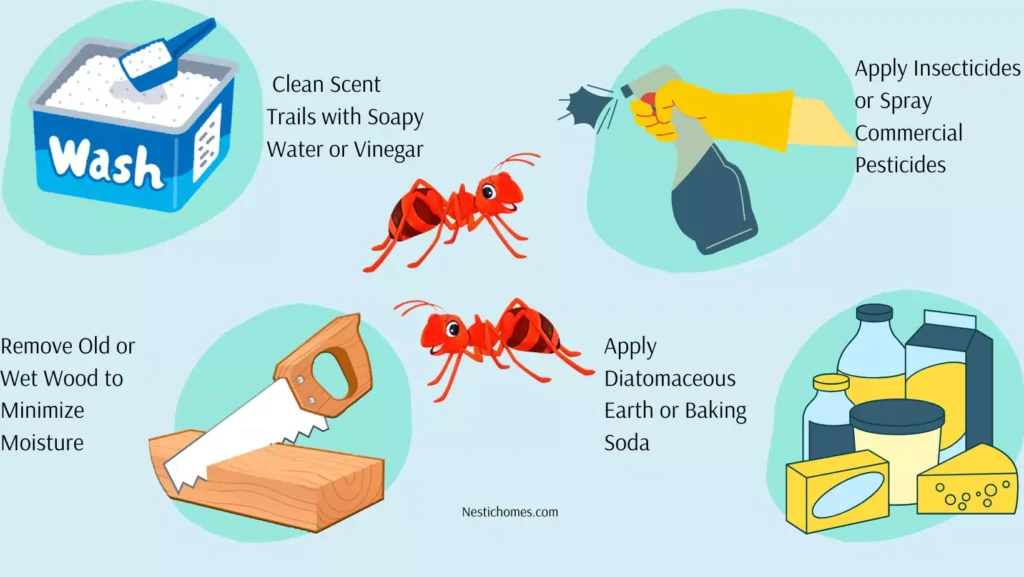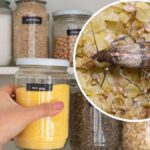Last updated on July 2nd, 2025 at 07:55 am
Carpenter ants can be a frustrating and costly problem for homeowners and businesses. Unlike termites, they don’t eat wood but burrow through it to create nests, causing extensive structural damage.
If you’re dealing with these carpenter ants, We got ya. In this blog post, you will learn about how to get rid of carpenter ants, explore natural solutions, and explain the differences between carpenter ants, termites, and other common issues and solutions.
What Are Carpenter Ants & Why Are They in Your Home?
Carpenter ants are a type of large ant known for their ability to tunnel through wood to create their nests. They are typically dark-colored, ranging from black to reddish-brown, and can grow to about 1/4 to 1/2 inch in size. You might notice large, winged carpenter ants inside or outside your home—these are swarmers looking to mate and establish new colonies.
But why are they invading your home? Carpenter ants are often attracted to moist, rotting wood, which makes your home an excellent location for nesting, especially if there are water leaks, damp walls, or decaying wood in your property.
According to pest control expert Amanda Hayes, “Carpenter ants are one of the top culprits for wood damage in homes, surpassed only by termites. Keeping your home dry and free from rotting wood is essential in preventing an infestation.”
RELATED BLOG
- How to Permanently Get Rid of Drain Flies in 5 Minutes
- How to Permanently Get Rid of Ground Bees 12 Fastest Ways
Types of Carpenter Ants

Interestingly, there are over 1,000 species of carpenter ants globally, but only a few are commonly found in homes and businesses.
- Black Carpenter Ants (Camponotus pennsylvanicus): Predominantly found in North America, these large ants are black and are the most common culprits for property damage.
- Florida Carpenter Ants (Camponotus floridanus): Known for their reddish-brown hue, these ants are more often a nuisance in humid regions.
- Camponotus Modoc: This species is mostly found in the Pacific Northwest and causes significant structural problems since they prefer densely wooded areas.
Regardless of their specific type, the treatment for carpenter ants is usually the same, involving a mix of targeted elimination techniques and preventative measures.
How to Get Rid of Carpenter Ants
Here’s the great news—getting rid of carpenter ants is entirely possible with the right strategies. Below is a carefully curated list of solutions, ranging from DIY to professional options:
1. Identify and Destroy the Nest
The first step in eliminating carpenter ants is to correctly identify their presence and locate the nest. Carpenter ants are larger than common ants and are often black or red. Use a flashlight to inspect moisture-prone areas like basements, kitchens, and near outdoor trees. Once you find the nest, you can act swiftly to destroy it:
- Inject boric acid into nests: Boric acid is highly effective because ants carry it back to the colony, killing the entire nest.
- Direct nest treatment: Dismantle-infested wood carefully to remove and dispose of the nest far from your home.
- Replace wet, decaying wood: If the nest is inside damaged wood, replacing it is critical to prevent re-infestation.
2. Set Baits Indoors and Outdoors
Indoor bait traps are an easy solution. Choose sweet or protein-based baits containing chemicals like borax or hydramethylnon. Ants take the bait back to the colony, infecting others. For outdoor colonies, place ant baits near stumps, trees, or mulch piles to prevent them from spreading indoors.
3. Apply Diatomaceous Earth or Baking Soda
For a natural and eco-friendly option, sprinkle diatomaceous earth or baking soda around areas with ant activity. Diatomaceous earth dehydrates the ants, while baking soda disrupts their internal systems. Both methods are safe for pets when used properly.
4. Use Essential Oils and Vinegar
Essential oils like peppermint, tea tree, or citrus oils work as natural repellents. Mix a few drops with water and spray around entry points or ant trails. Additionally, vinegar diluted with water can disrupt their scent trails, making it harder for ants to navigate.
5. Clean Scent Trails with Soapy Water or Vinegar
Ants rely on chemical trails to communicate. Wipe these trails with soapy water or a vinegar solution to disrupt their navigation and prevent further infestations.
6. Prune Trees and Store Firewood Properly
Carpenter ants often enter homes through overhanging tree branches or firewood stored too close to your house. Regularly prune trees and shrubs near your home and store firewood away from the exterior walls.
7. Remove Old or Wet Wood to Minimize Moisture
Carpenter ants thrive in wet, decaying wood. Replace rotting wood in your home and fix moisture problems, such as leaks or poor ventilation, to make your space less attractive to ants.
8. Seal Entry Points
Inspect your home for cracks along windows, doors, and baseboards. Use caulk to seal these openings and prevent ants from entering.
9. Apply Insecticides or Spray Commercial Pesticides
For severe infestations, consider using commercial insecticides or pesticides specifically designed for carpenter ants. Spray around entry points and ant trails for maximum effectiveness.
10. Contact an Exterminator
If DIY methods fail, it’s time to call a professional. Exterminators have advanced tools and treatments, such as baiting systems and chemical applications, to remove even the most stubborn colonies.
Fastest Ways to Kill Carpenter Ants Naturally
- Essential Oils: Spray peppermint, tea tree, or citrus oil mixed with water along ant trails and nest sites.
- Vinegar: Spray a solution of vinegar and water directly on ants or at entry points to kill and repel them.
- Boric Acid: Acting as an effective natural insecticide, this powder works wonders when applied correctly to nests.
Carpenter Ants vs. Termites
Carpenter ants are often mistaken for termites due to their shared love of wood. The key difference? Termites consume wood, whereas carpenter ants excavate it. Additionally, termites tend to have straight antennae and uniform wings, while carpenter ants have bent antennae and unequal wing pairs.
Carpenter Ants vs. Regular Ants
Unlike most ants that forage on the surface, carpenter ants are nocturnal and love burrowing into wood. They are significantly larger than regular ants, making them easier to spot—but also harder to eliminate.
Carpenter Ants vs. Black Ants
While all carpenter ants are technically black or reddish-black, “black ants” commonly refers to harmless black garden ants (Lasius niger), which are much smaller and less destructive.
Common FAQs About Carpenter Ants
Q1. What scent keeps carpenter ants away?
Essential oils like peppermint, tea tree, and citrus are highly effective at repelling ants. Spray them in high-risk areas to prevent infestations.
Q2. Does salt get rid of carpenter ants?
Salt can act as a natural ant deterrent. While it won’t kill colonies outright, sprinkling salt along entry points can repel ants from entering.
Q3. Which is better for killing ants, borax or baking soda?
Borax is the better option for killing entire colonies as it disrupts their digestive systems. Baking soda is less potent but works well when sprinkled on active trails.
Q4. What are carpenter ants most attracted to?
Carpenter ants are primarily attracted to damp or decaying wood, which provides ideal nesting conditions. They are also drawn to sweet substances like sugar, honey, or syrup, as well as protein-rich foods. Eliminating moisture sources and sealing food containers can significantly reduce the chances of attracting these pests into your home.







